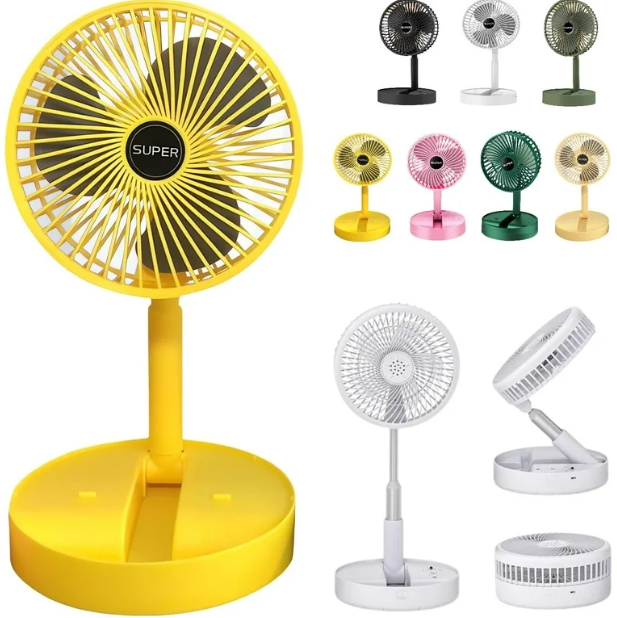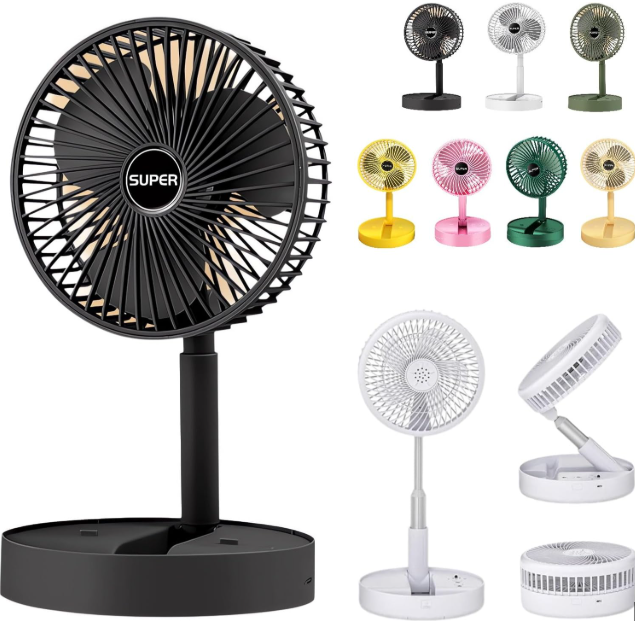When summer heat demands powerful cooling, a high speed electric fan delivers the intense airflow needed to keep your space comfortable. This high speed electric fan reviews guide highlights the top high-velocity fans for 2025, focusing on their cooling power, durability, and features. From electric fan setup to electric fan troubleshooting, we’ll cover everything you need to choose the best electric fan for large rooms, garages, or workshops. These fans are designed for maximum airflow, making them ideal for those who need robust cooling solutions. Our electric fan tips will help you optimize performance and stay cool efficiently.
Why Choose a High Speed Electric Fan?
High speed electric fans are engineered to move large volumes of air quickly, often exceeding 12 mph in wind speed, making them perfect for large spaces or intense heat. They typically consume 50-150 watts, offering a cost-effective alternative to air conditioners at roughly 1-3 cents per hour. These fans are ideal for garages, warehouses, or homes with open layouts, providing strong, focused airflow. This high speed electric fan reviews guide evaluates models based on airflow (measured in cubic feet per minute, or CFM), noise levels, and build quality to help you find the right fan.
Types of High Speed Electric Fans
High speed fans come in various forms, each suited for specific needs. Here’s an overview of the main types available in 2025:
- Floor Fans: Powerful and portable, these are ideal for garages, workshops, or large living areas, often with adjustable tilt for directed airflow.
- High-Velocity Tower Fans: Slim and powerful, these combine high airflow with a compact design, perfect for homes with limited space.
- Pedestal Fans: Adjustable in height, these deliver strong airflow for medium to large rooms, often with oscillation.
- Industrial Fans: Heavy-duty models designed for commercial spaces or large workshops, offering maximum CFM for intense cooling.
- Wall-Mounted Fans: Space-saving and high-powered, these are great for fixed installations in gyms or warehouses.
Choose based on your space and cooling requirements for the best electric fan experience.
Electric Fan Setup: Getting Started
Proper electric fan setup ensures your high speed fan performs optimally. Follow these steps:
- Unbox and Inspect: Check for all components, such as the base, blades, or mounting hardware, ensuring no damage.
- Assemble Securely: Attach the base or mount (for wall fans) as per the manual, using screws or clips for stability.
- Position Strategically: Place floor or pedestal fans on a stable surface, or mount wall fans securely. Angle the fan to direct airflow where needed.
- Plug In and Test: Connect to power and test all speed settings, tilt, or oscillation features to confirm functionality.
Position the fan to create a cross-breeze, such as near a window or door, to maximize cooling. Ensure stability to prevent tipping, especially in high-traffic areas.

How to Use a High Speed Electric Fan Effectively
Knowing how to use an electric fan can enhance cooling efficiency. Here are some electric fan tips:
- Direct Airflow: Use the fan’s adjustable tilt to focus airflow on specific areas, like workstations or seating areas.
- Create a Cross-Breeze: Position near an open window or door to pull in cooler air, enhancing circulation.
- Adjust Speeds: Use high speeds for rapid cooling in large spaces and lower speeds for quieter operation in smaller areas.
- Use Timers: Set timers (if available) to save energy, especially for overnight use.
Pairing a high speed fan with an air conditioner can circulate cool air, reducing AC usage and energy costs.
Electric Fan Maintenance: Keeping It Running Strong
Regular electric fan maintenance ensures durability and performance. Follow these steps:
- Clean Regularly: Dust on blades or grilles reduces airflow. See our electric fan cleaning guide below.
- Inspect Cords: Check for fraying or damage to the power cord or plug. Stop using if issues are found.
- Tighten Components: Secure loose screws or parts to minimize vibration and noise, especially in high-velocity models.
- Store Properly: Store in a dry, dust-free area when not in use to protect internal components.
Consistent maintenance keeps your fan efficient and safe for heavy use.
How to Clean a High Speed Electric Fan
Electric fan cleaning is essential for maintaining airflow and air quality. Here’s how to clean your high speed electric fan:
- Unplug the Fan: Disconnect from power to ensure electric fan safety.
- Remove Grilles or Covers: Detach grilles or covers as per the manual, typically by unscrewing or unclipping.
- Clean Blades: Vacuum dust or wipe blades with a dry cloth. Use a damp cloth with mild soap for stubborn dirt, avoiding electronics.
- Wash Grilles: Soak removable grilles in warm, soapy water, scrub gently, and dry thoroughly.
- Reassemble and Test: Reassemble and test all functions to ensure proper operation.
Clean every 2-4 weeks during frequent use to prevent dust buildup and maintain high airflow.
Electric Fan Troubleshooting: Fixing Common Issues
Even the best electric fan may encounter problems. Here’s a guide to electric fan troubleshooting:
- Fan Won’t Start: Check the power cord, plug, or outlet. Test the outlet with another device.
- Weak Airflow: Dust buildup can reduce performance. Clean blades and grilles thoroughly.
- Excessive Noise: Vibration or debris may cause rattling. Tighten screws or remove obstructions.
- Overheating: High speed fans can overheat if run continuously. Use timers or lower speeds for extended use.
If issues persist, consult the manufacturer or a technician.
Electric Fan Safety: Staying Safe
Electric fan safety is critical, especially with high speed models. Follow these guidelines:
- Avoid Water: Keep fans away from water or damp areas to prevent electrical hazards.
- Child and Pet Safety: Choose fans with tight grilles or bladeless designs to prevent fingers or paws from reaching blades.
- Limit Continuous Use: Use timers to avoid overnight operation, reducing motor overheating risks.
- Inspect Regularly: Check cords, plugs, and components for wear before use.
These precautions ensure safe operation of your high speed electric fan.

Key Features to Look for in a High Speed Electric Fan
When selecting a high speed electric fan, consider these features for optimal performance:
- High Airflow (CFM): Look for fans with at least 1500 CFM for large spaces; higher is better for industrial use.
- Multiple Speed Settings: 3-9 speeds for customizable airflow.
- Adjustable Tilt or Oscillation: Directs airflow precisely or covers a wider area.
- Quiet Operation: Noise levels below 50 dB on high for indoor use; industrial fans may be louder.
- Durable Build: Metal blades or sturdy plastic for heavy-duty use.
- Portability: Handles or lightweight designs for easy movement.
Features like remote controls or timers add convenience, especially for home use.
Best Electric Fan Guide: Top High Speed Electric Fans for 2025
Based on recent testing and user feedback, here are the top high speed electric fans for 2025, evaluated for airflow, noise, and durability:
-
- Vornado 753 High Velocity Floor Fan: This floor fan (14.8 x 15.2 x 6.8 inches, 9.3 pounds) delivers powerful airflow (up to 12 mph, 5100 CFM) with three speeds and a 360-degree tilt. Its vortex design circulates air up to 100 feet, ideal for large rooms or garages. It uses 70-100 watts, costing about $2-3 per month for daily use, and operates at 50-56 dB, quieter than most high-velocity fans. The sturdy build and five-year warranty add reliability, though it lacks a remote. Best for: Large spaces needing strong airflow.
-
- Commercial Electric 20-Inch High Velocity Floor Fan: This robust fan (22 x 22 x 7 inches, 12 pounds) offers three speeds with up to 4800 CFM and a 360-degree tilt. Its metal blades and powder-coated finish ensure durability for garages or workshops. It’s quieter than expected (55-60 dB on high) with non-skid feet to reduce vibration. It uses 100-150 watts, but the carry handle enhances portability. Assembly is minimal, though it’s noisier on high settings. Best for: Industrial or commercial use.
-
- Shark TurboBlade Tower Fan: This 42-inch tower fan (13 x 13 x 42 inches, 10 pounds) delivers high-velocity airflow (up to 25 ft/s, 1600 CFM) with five speeds and 180-degree oscillation. Its pivoting arm and adjustable vents allow precise airflow direction. It’s relatively quiet (40-50 dB) and uses 40-60 watts, with a magnetic remote for convenience. The sturdy base prevents tipping, but cleaning internal blades is challenging. Best for: Versatile home cooling.
-
- Lasko 20-Inch Wind Machine: This floor fan (23.4 x 7.3 x 25.4 inches, 9.3 pounds) provides strong airflow (up to 4750 CFM) with three speeds and a pivoting head. It’s ideal for garages or large rooms, with a durable build and carry handle. It operates at 50-65 dB, louder on high, and uses 90-120 watts. It’s affordable but lacks oscillation. Best for: Budget-friendly high-velocity cooling.
-
- Hampton Bay Personal High Velocity Fan: This compact fan (6 x 6 x 4 inches, 2 pounds) delivers surprising power (up to 10 mph, 600 CFM) for its size, with three speeds and adjustable tilt. It’s perfect for small spaces or personal use, using 30-50 watts and operating at 45-55 dB. Its lightweight design is portable, but the grille allows finger access, so it’s less safe for kids. Best for: Personal, budget-friendly cooling.
These models excel in airflow, build quality, and value, making them top picks in our high speed electric fan reviews.
Conclusion: Stay Cool with the Best High Speed Electric Fan
This high speed electric fan reviews guide has explored the top high-velocity fans for 2025, offering insights into their setup, use, and maintenance. By mastering electric fan setup, electric fan cleaning, and electric fan troubleshooting, you can ensure powerful, reliable cooling. Prioritize electric fan safety and electric fan maintenance to extend your fan’s lifespan. Whether you choose the robust Vornado 753 for large spaces or the compact Hampton Bay for personal use, these high speed electric fans deliver the intense airflow needed to beat the heat. Stay cool and comfortable with the best electric fan for your needs!